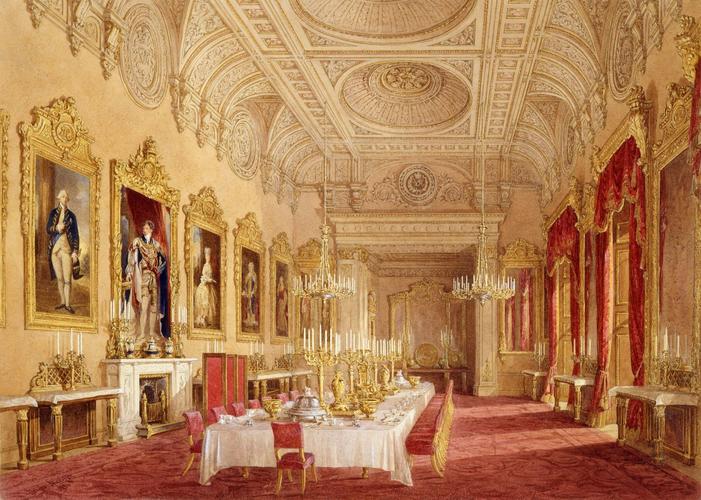-
1 of 253523 objects
The State Dining Room, Buckingham Palace signed 1843
Watercolour and bodycolour over pencil | 27.2 x 38.1 cm (sheet of paper) | RCIN 919898

Douglas Morison (1814-1847)
The State Dining Room, Buckingham Palace signed 1843


-
A watercolour depicting a topographical view of the interior of the State Dining Room at Buckingham Palace. Signed and dated lower left: Douglas Morison / 1843.
Morison was commissioned in 1843 by Queen Victoria and Prince Albert, who became keen collectors of the fashionable nineteenth-century watercolour genre of interior views, to paint a series of interiors of Buckingham Palace (RCINs 919897-919901, 919912 and 919917). All but one of these watercolours were exhibited at the Old Watercolour Society annual exhibition in 1844, and attracted a satirical review from William Makepeace Thackeray, who was writing under the pseudonym Michael Angelo Titmarsh.
In John Nash's plans for the palace, the south end of the new Picture Gallery on the first floor was intended to open into a music room, mirroring an identical arrangement on the floor below where the Marble Hall was designed to open into a dining room. Although the new Music Room (and the Dining Room below) were well advanced at the time of Nash's dismissal in 1830, Nash's successor Edward Blore was asked by William IV to provide a new State Dining Room on the first floor, linked directly to the enfilade of new rooms constructed by Nash on the west (garden) front of the palace. This decision entailed taking down and rebuilding the Music Room as a dining room on a new site approximately 6 metres further west. Building work was carried out in 1833-4, but the decoration and fitting-out of the room continued into the early years of Queen Victoria's reign. The picture hang in the new room, which dates from c.1840, included Gainsborough's full lengths of George III and Queen Charlotte (replaced in 1950 with Ramsay's State Portraits of the same sitters) and the same artist's portraits of the Duke and Duchess of Cumberland, bequeathed to the future William IV by the Duchess of Cumberland in 1808. In the first fifteen years of her reign, Queen Victoria used the State Dining Room for dinners for up to sixty guests, often in connection with a ball. On such occasions, the table and buffet at the south end were used for magnificent displays of gold plate, much of it from George IV's enormous collection, supplemented on occasions by pieces that the Queen and Prince Albert had acquired themselves. The buffet arrangement was swept away in the early 1850s to make a route through to the new Ballroom, designed by Sir James Pennethorne and built by Thomas Cubitt under Prince Albert's direction. Thereafter this enormous room took the place of the Picture Gallery for large entertainments.
Catalogue entry from Royal Treasures, A Golden Jubilee Celebration, London 2002Provenance
Commissioned by Queen Victoria and Prince Albert (12 gns)
-
Medium and techniques
Watercolour and bodycolour over pencil
Measurements
27.2 x 38.1 cm (sheet of paper)
Object type(s)
Other number(s)
RL 19898Alternative title(s)
Buckingham Palace: the Banqueting or State Dining-Room